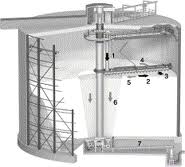Difference between revisions of "Mammoth Silos"
PurplePen19 (talk | contribs) |
|||
| Line 1: | Line 1: | ||
[[Category:Silos, Hoppers]]{{Knoppen}} | [[Category:Silos, Hoppers]]{{Knoppen}} | ||
[[File:Mammoth Silos.jpg|thumb|200px|right|Mammoth Silos]] | [[File:Mammoth Silos.jpg|thumb|200px|right|Mammoth Silos]] | ||
'''Mammoth Silos''' are largcommonly used in calculating homogenization efficiency and modeling input properties. The homogenization theory of mammoth silos is investigated in order to establish the homogenization efficiency of mammoth silos. These [[silos]], where homogenization is achieved by intersecting multiple layers during reclaiming of the silo, e.g., by inclining the [[Screw Conveyors | |||
|screw conveyor]], can be used for large-scale homogenization of both cohesive and free-flowing materials and are therefore an alternative for blending piles. | |||
The presented homogenization model and the calculation of the homogenization efficiency in mammoth silos depend on two variables: the volume distribution and the input properties of the bulk material to be homogenized. The silo geometry and the chosen stacking and reclaiming method determine the first variable. The second variable, time series representing the input properties of a material flow, depends on the material to be homogenized. | |||
The presented homogenization model and the calculation of the homogenization efficiency in | |||
Revision as of 06:47, 12 April 2013
Mammoth Silos are largcommonly used in calculating homogenization efficiency and modeling input properties. The homogenization theory of mammoth silos is investigated in order to establish the homogenization efficiency of mammoth silos. These silos, where homogenization is achieved by intersecting multiple layers during reclaiming of the silo, e.g., by inclining the [[Screw Conveyors |screw conveyor]], can be used for large-scale homogenization of both cohesive and free-flowing materials and are therefore an alternative for blending piles.
The presented homogenization model and the calculation of the homogenization efficiency in mammoth silos depend on two variables: the volume distribution and the input properties of the bulk material to be homogenized. The silo geometry and the chosen stacking and reclaiming method determine the first variable. The second variable, time series representing the input properties of a material flow, depends on the material to be homogenized.
Common Advantages
- No pollution of the environment by dust or ground water percolation
- No moisture increase by rain, snow etc. and consequently no or only limited product degradation
- Considerably smaller space requirements than other storage systems
- Reclamation of very cohesive materials even after three months, no more limitation on storage periods
- Possibility for dynamic coal blending when reclaiming two (or more) silos simultaneously at a controlled rate
- High availability of equipment
- Low operating costs
- Low maintenance costs
- Significant savings on fuel costs
Typical Features
- The silo structure can be built as: a steel structure with a wooden innerwall and a standard outerwall cladding, slipformed concrete silo or as a steel tank
- Tracing and/or insulation of the outerwall
- Existing oil tanks can be converted into a silo by installing a system inside
- Drainage of the silo and by installing a vacuum unit additional dewatering can be achieved
- Complete remote control based on data bus systems
